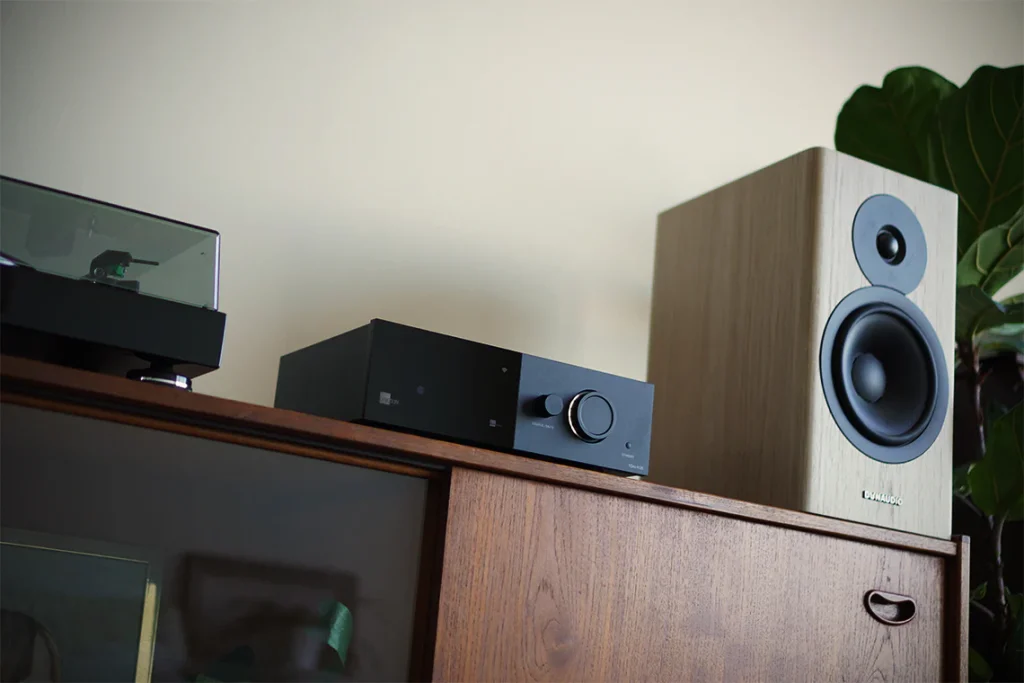Bookshelf speakers are the sweet spot for most home audio setups — compact, stylish, and capable
of delivering incredible sound clarity without taking over your living room. Whether you’re pairing
them with a new integrated amplifier or upgrading an existing system, this guide highlights the
best bookshelf speakers for 2025. We’ve tested and compared the top-performing models under different budgets and room sizes.
For each recommendation, you’ll find pros, cons, and a direct Amazon link to
help you make an informed purchase.
Affiliate Disclosure: AmplifierZone is reader-supported. As an Amazon Associate, we may earn commissions from qualifying purchases at no extra cost to you.
Top 5 Bookshelf Speakers for 2025
| Model | Power Range | Sensitivity | Best For |
|---|---|---|---|
| ELAC Debut 2.0 B6.2 | 30–120W | 87 dB | Balanced Sound |
| Klipsch R-51M | 25–85W | 93 dB | Lively Highs & Clarity |
| Q Acoustics 3020c | 25–75W | 88 dB | Neutral & Detailed |
| KEF Q150 | 10–100W | 86 dB | Wide Soundstage |
| Polk Audio Signature Elite ES20 | 20–125W | 88 dB | Dynamic Bass |
1. ELAC Debut 2.0 B6.2 – Best Overall Bookshelf Speaker
The ELAC Debut 2.0 B6.2 continues to dominate in the sub-$400 range.
Known for its clean, detailed sound and solid build, it’s perfect for listeners who want balance across lows, mids, and highs.
When paired with a high-quality integrated amp like the
Yamaha A-S301,
the ELACs produce a wide soundstage that feels immersive yet natural.
- Pros: Balanced frequency response, excellent build quality.
- Cons: Slightly large for small desks.
2. Klipsch R-51M – Best for Bright, Lively Sound
Klipsch’s R-51M delivers an energetic, dynamic sound signature thanks to its
signature horn-loaded tweeter. Perfect for rock or jazz lovers who like forward mids and sparkling highs.
Pair them with a warmer amp such as the
Denon PMA-600NE
for best tonal balance.
- Pros: Very efficient, ideal for low-powered amps.
- Cons: Highs can be harsh in small rooms.
3. Q Acoustics 3020c – Most Natural Sound
The 3020c from Q Acoustics is praised for its natural tonality and controlled bass response.
They’re ideal for listeners who prefer accuracy over loudness. Combine them with the
Cambridge AXA35
for a clean, balanced performance.
- Pros: Excellent imaging, detailed mids.
- Cons: Requires placement away from walls.
4. KEF Q150 – Best Soundstage and Imaging
The KEF Q150 uses a Uni-Q driver that blends highs and mids perfectly, producing a
wide stereo image and crisp separation. It’s especially good for classical or acoustic music.
- Pros: Expansive soundstage, premium finish.
- Cons: Needs a bit of power to shine.
5. Polk Audio Signature Elite ES20 – Best Bass in Class
If you like a little more punch, the Polk Audio ES20 delivers deep, controlled bass and warm mids.
Its Power Port technology enhances low-end response, making it ideal for movies or bass-heavy tracks.
- Pros: Great bass response, strong build quality.
- Cons: Slightly large footprint.
Bookshelf Speaker Setup Tips
- Place speakers on solid stands or shelves at ear level.
- Keep at least 8–12 inches of clearance from the back wall for optimal bass.
- Toe-in slightly for tighter stereo imaging.
For amplifier matching, check out our detailed guide on
how to match your amplifier to your speakers.
Buying Guide: What to Look for in Bookshelf Speakers
1. Sensitivity and Power
Choose speakers with 87–90dB sensitivity for typical home setups. High sensitivity means less power needed.
2. Impedance
Most models are rated at 6–8Ω, compatible with popular amps like the
Denon PMA-600NE
or Yamaha A-S301.
3. Room Size
Smaller rooms work best with compact models like the Q Acoustics 3020c, while larger spaces benefit from
more powerful speakers such as the ELAC B6.2 or Polk ES20.
Final Verdict
The ELAC Debut 2.0 B6.2 takes the crown as the best overall bookshelf speaker for 2025,
combining performance, build, and value.
However, each option on this list excels in its own right — whether you crave lively highs (Klipsch R-51M)
or rich low-end (Polk ES20).
For best results, pair your chosen speakers with a quality integrated amp from our guide on
best stereo amplifiers under $500.
Disclosure: This article contains affiliate links. We may earn a commission if you buy through them — at no extra cost to you.

